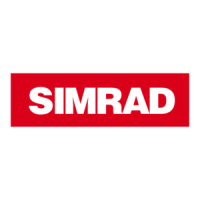Getting started
31
857-160970 / Rev.H
Note that if you operate in Replay mode, the transceiver settings
can not be changed.
Additional information about the transceiver settings are
available if you press the Advanced buttonintheTransceiver
Settings dialogue box.
Bottom detector settings
The Header view on the display is also used to present the
current depth. The Bottom Detector dialogue box is used to
define various parameters associated with the bottom detection.
These include the depth range, where the ES60 searches for the
bottom.
In our example we will assume that the depth will vary between
30 and 200 meters. Therefore, set Minimum Depth to 30 m and
Maximum Depth to 200 m. Click OK to accept the settings.
Note Setting both Minimum Depth and Maximum Depth to 0 m will
turn off bottom detection.
Colour scale
The Colour Scale field is used to display the colour scale for
mapping acoustical values. These colours are used in the Single
Echo and Echogram and Range views. Each colour always
represents a 3 dB value range. Using all 12 colours in the colour
scale thus enables mapping of a 36 dB value range to colours.
Position the cursor over the colour scale, click the right mouse
button to open the Colour Scale dialogue box. Accept the
default settings and click OK.
Single Echo view
The Single Echo view on the display contains information on
detection of single echoes. Two plots are visible in this view.
• One plot shows a histogram of the TS distribution for the
single echoes detected in the Echogram and Range view. For
an accurate x-axis value, place the cursor inside the
coordinate system, and read the value from the displayed
label.
• The other plot shows the position within the beam of the
detected single echoes for the current ping (largest circles)
and the three previous ping (smaller circles).

